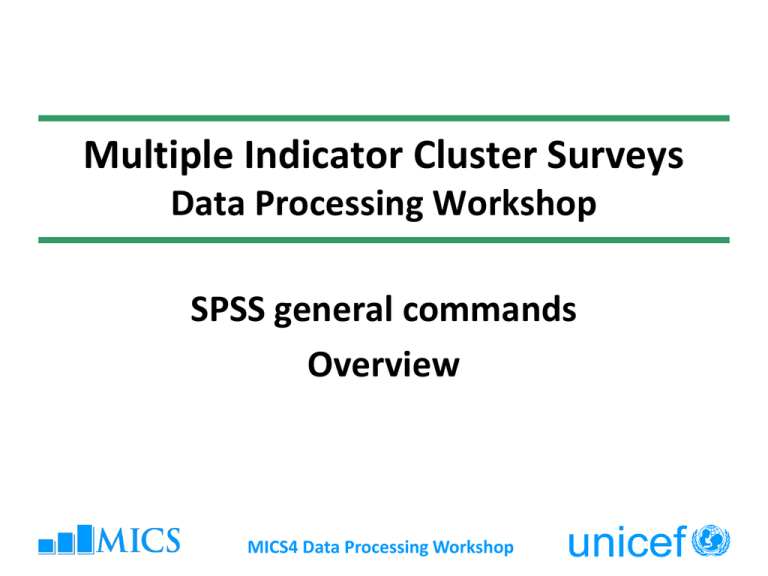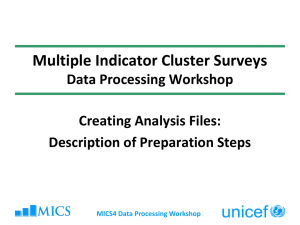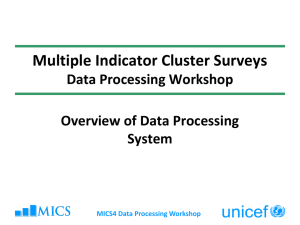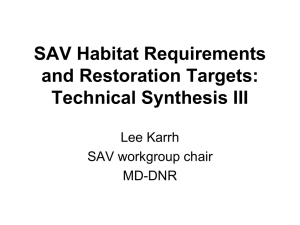MICS Data Processing Workshop
advertisement

Multiple Indicator Cluster Surveys Data Processing Workshop SPSS general commands Overview MICS4 Data Processing Workshop SPSS Statistics – Statistical Package for the Social Sciences – SPSS is a full-featured data analysis program that offers a variety of applications including data base management, statistical analysis and graphics – The SPSS program runs on a wide variety of mainframe, mini, and microcomputers – The most recent version is SPSS 20, which runs on both Windows and Macintosh computers MICS4 Data Processing Workshop Data management using the SPSS Statistics command language – Data bases: • FILE_NAME.SAV – IN MICS: HH.sav, TN.sav, HL.sav, WM.sav, CH.sav, BH.sav, FG.sav and MN.sav • • • • • Getting Data into SPSS Statistics Merging data Aggregating data Weighting data And many more MICS4 Data Processing Workshop Programming with SPSS Statistics – SPSS syntax files: • FILE_NAME.SPS • Build and run command syntax • Get data, add new variables, and append cases to the active dataset • Create new datasets • Concurrently access multiple open datasets • Get output results • Create tables • And many more MICS4 Data Processing Workshop Programming with SPSS Statistics • Although many of the tasks can be performed with the menus and dialog boxes, some very powerful features are available only with command syntax MICS4 Data Processing Workshop Creating Command Syntax Files • An command file is a simple text file. You can use any text editor to create a command syntax file, but SPSS Statistics provides a number of tools to make your job easier • Use the Paste button. Make selections from the menus and dialog boxes, and then click the Paste button instead of the OK button. This will paste the underlying commands into a command syntax window. MICS4 Data Processing Workshop Creating Command Syntax Files • SPSS program commands follow very specific syntax rules, which are described in various SPSS publications: • All commands must begin in the first column of a line and be spelled correctly MICS4 Data Processing Workshop Creating Command Syntax Files • Most commands include additional information (e.g., names of variables the command is to be applied to, options for processing data, displaying results, etc.)which may be continued on the same line using the appropriate delimiter (e.g., blank space, comma, slash) • or continued on an additional line(s) provided that the continuation begins after column 1 MICS4 Data Processing Workshop Creating Command Syntax Files • Commands can be typed in either upper or lower case • Most SPSS commands have default specifications, i.e., the options that will be used unless you tell SPSS to use something else MICS4 Data Processing Workshop Overview of the commands – – – – Data definition File interfaces Analyze data Modify data MICS4 Data Processing Workshop Data definition – These commands: (1) bring raw data into SPSS, either from another file, or by typing it in yourself, and (2) enter descriptive information about the data. MICS4 Data Processing Workshop Data definition Commands: DATA LIST VARIABLE LABELS VALUE LABELS MISSING VALUES MICS4 Data Processing Workshop Data list EX: DATA LIST FILE='C:\MICS4\SPSS\MYHH.DAT' RECORDS=1 MICS4 Data Processing Workshop Variable and value labels EX: variable label type "Main source of drinking water". value label type 1 "Improved sources" 2 "Unimproved sources". MICS4 Data Processing Workshop File interfaces • These commands access and save SPSS system files MICS4 Data Processing Workshop File interfaces Commands: GET FILE SAVE OUTFILE MICS4 Data Processing Workshop Get file EX: get file = 'hh.sav'. Set outfile = 'hh.sav'. MICS4 Data Processing Workshop Analyze data • These commands actually do statistical analysis ex. frequencies variables=hc2 hc3 hc4 hc5 hc6 hc8 hc8a hc9a hc9b hc9c hc9d hc9e hc9f hc9g hc9h hc9i hc9j hc9k hc9l hc9m hc9n hc9o hc10a hc10b hc10c hc10d hc10e hc10f hc11 hc12 hc13 hc14a hc14b hc14c hc14d hc14e hc14f ws1 ws2 ws7 /statistics=stddev mean /order=analysis . MICS4 Data Processing Workshop Modify data • These commands alter data and change file characteristics. MICS4 Data Processing Workshop Modify data • These commands alter data and change file characteristics. MICS4 Data Processing Workshop Modify data Commands: COMPUTE RECODE IF SELECT IF MICS4 Data Processing Workshop Compute Ex. compute persroom = 99. if (hc2 < 98) persroom = hh11/hc2. variable label persroom 'Persons per sleeping rooms'. missing values persroom (99). MICS4 Data Processing Workshop Recode Ex. recode improved (100 = 1) (else = 2) into type. variable label WS1 "". variable label type "Main source of drinking water". value label type 1 "Improved sources" 2 "Unimproved sources". MICS4 Data Processing Workshop IF compute improved = 0. if (WS1 = 11 or WS1 = 12 or WS1 = 13 or WS1 = 14 or WS1 = 15 or WS1 = 21 or WS1 = 31 or WS1 = 41 or WS1 = 51) improved = 100. if ((WS2 = 11 or WS2 = 12 or WS2 = 13 or WS1 = 14 or WS1 = 15 or WS2 = 21 or WS2 = 31 or WS2 = 41 or WS2 = 51) and WS1 = 91) improved = 100. variable label improved "Percentage of household population using improved sources of drinking water *". MICS4 Data Processing Workshop SELECT IF select if (hh9 = 1). select if (wm7 = 1). select if (uf9 = 1). MICS4 Data Processing Workshop MERGING FILES IN MICS4 • 4 – 8 SPSS MICS4 data files are produced for each survey, corresponding to the main units of analysis: • Households - hh.sav • Household members - hl.sav • Women in reproductive age (15-49 years of age) – wm.sav • Children under the age of five – ch.sav • FGM – fg.sav • Birth history – bh.sav • Treated nets – tn.sav • Men in reproductive age (15 – 59 years of age) – mm.sav MICS4 Data Processing Workshop MERGING FILES IN MICS4 • hh.sav • Relations with: hl.sav, wm.sav, ch.sav, bh.sav, fg.sav, tn.sav, mm.sav • Base key variables: HH1 (cluster number) and HH2 (household number) MICS4 Data Processing Workshop MERGING FILES IN MICS4 • hl.sav • Relations with: wm.sav, ch.sav, mm.sav, bh.sav, fg.sav • Base key variables: HH1 (cluster number), HH2 (household number) and HL1 (member’s line number) MICS4 Data Processing Workshop MERGING FILES IN MICS4 • wm.sav, ch.sav, mn.sav • Relations with: hh.sav, hl.sav • Base key variables: HH1 (cluster number), HH2 (household number) and LN (HL1) (member’s line number) IMPORTANT NOTE: variable HL1 in hl.sav data file is named LN in wm.sav ,ch.sav and mn.sav files. Renaming of the variable is required prior to merging. MICS4 Data Processing Workshop MERGING FILES IN MICS4 • bh.sav • Relations with: hh.sav, hl.sav, wm.sav • Base key variables: HH1 (cluster number), HH2 (household number) and HL1 (member’s line number) MICS4 Data Processing Workshop MERGING FILES IN MICS4 • tn.sav • Relations with: hh.sav, hl.sav • Base key variables: HH1 (cluster number), HH2 (household number) and HL1 (member’s line number) MICS4 Data Processing Workshop MERGING FILES IN MICS4 • mn.sav • Relations with: hh.sav, hl.sav • Base key variables: HH1 (cluster number), HH2 (household number) and HL1 (member’s line number) MICS4 Data Processing Workshop Example on how to merge hh.sav onto a wm.sav • Make sure both files are sorted in ascending order by key variables before trying to merge. MICS4 Data Processing Workshop Example on how to merge hh.sav onto a wm.sav • From the menus choose: Data…. Merge Files…. Add Variables... MICS4 Data Processing Workshop Example on how to merge hh.sav onto a wm.sav • Select the file you wish to merge: If the file is already open select it from the list of „an open dataset“, and if it is not then browse for the file. MICS4 Data Processing Workshop Example on how to merge hh.sav onto a wm.sav • Select the file you wish to merge: MICS4 Data Processing Workshop Example on how to merge hh.sav onto a wm.sav • SPSS will give you a warning regarding sorted key variables. Make sure both files were sorted in ascending order before trying to do a file merge. MICS4 Data Processing Workshop Example on how to merge hh.sav onto a wm.sav * open the women file. get file ="wm.sav“. * sort cases by ID variables. sort cases HH1 HH2 LN. save outfile = "wm.sav". * open the household file. get file ="hh.sav". * sort cases by ID variables. sort cases HH1 HH2. save outfile = "hh.sav". * merge the household data file onto the women file. match files /file = "wm.sav" /table = 'hh.sav' /by HH1 HH2 . *save the women's file. save outfile = 'wm.sav'. MICS4 Data Processing Workshop Aggregate data • Aggregate data aggregates groups of cases in the active dataset into single cases and creates a new, aggregated file or creates new variables in the active dataset that contain aggregated data • Cases are aggregated based on the value of zero or more break (grouping) variables. If no break variables are specified, then the entire dataset is a single break group MICS4 Data Processing Workshop Aggregate data DATASET ACTIVATE DataSet1. DATASET DECLARE aggr. AGGREGATE /OUTFILE='aggr‘ /BREAK=HH1 HH2 /HL6_mean_1=MEAN(HL6). MICS4 Data Processing Workshop





